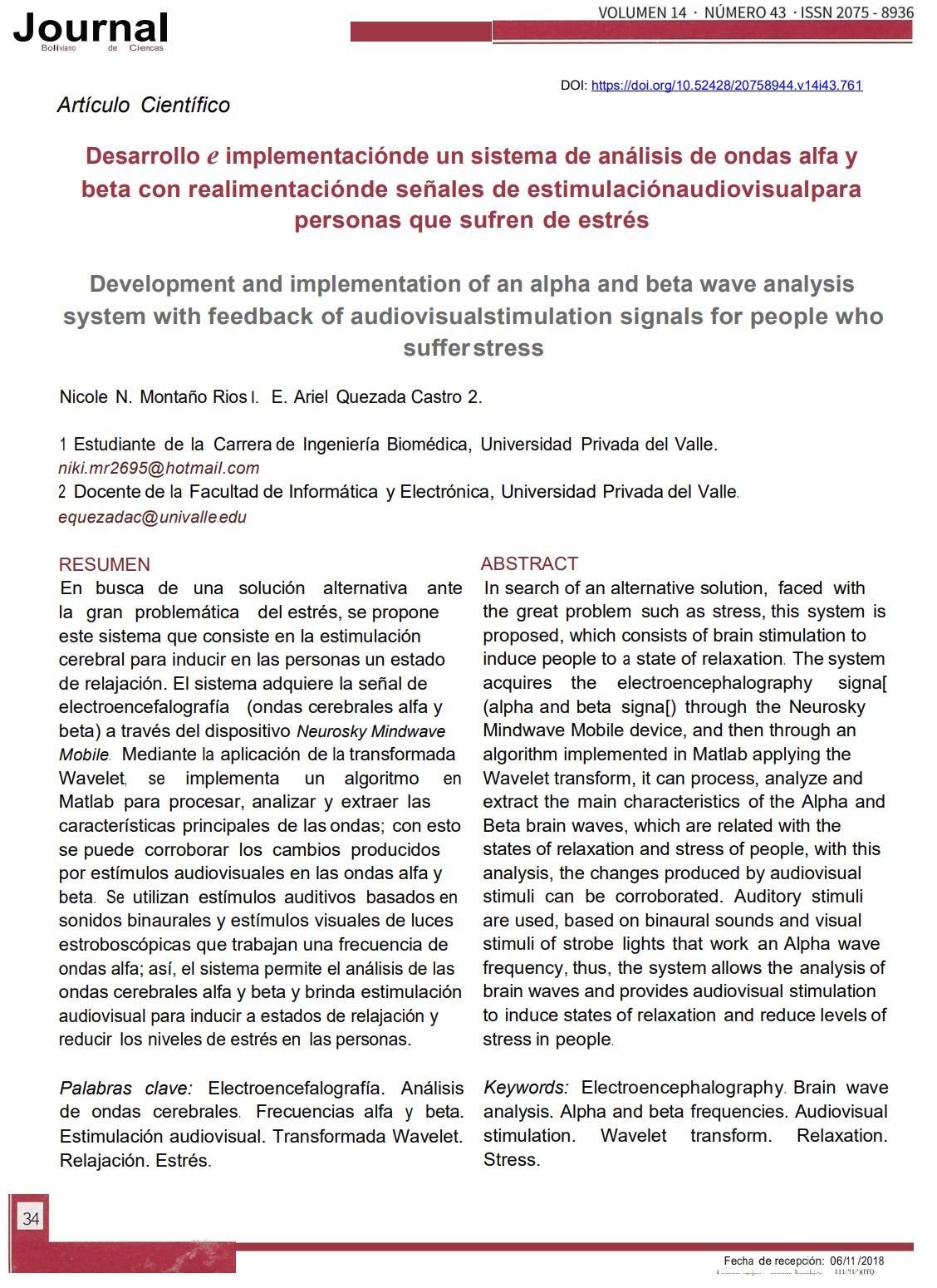Development and Implementation of an Alpha and Beta Wave Analysis System with Feedback of Audiovisual Stimulation Signals for People who Suffer Stress
DOI:
https://doi.org/10.52428/20758944.v14i43.761Keywords:
Electroencephalography, Brain Wave Analysis, Alpha and Beta Frequencies, Audiovisual Stimulation, Wavelet Transform, Relaxation, StressAbstract
In search of an alternative solution, faced with the great problem such as stress, this system is proposed, which consists of brain stimulation to induce people to a state of relaxation. The system acquires the electroencephalography signal (alpha and beta signa[) through the Neurosky Mindwave Mobile device, and then through an algorithm implemented in Matlab applying the Wavelet transform, it can process, analyze and extract the main characteristics of the Alpha and Beta brain waves, which are related with the states of relaxation and stress of people, with this analysis, the changes produced by audiovisual stimuli can be corroborated. Auditory stimuli are used, based on binaural sounds and visual stimuli of strobe lights that work an Alpha wave frequency, thus, the system allows the analysis of brain waves and provides audiovisual stimulation to induce states of relaxation and reduce levels of stress in people.
Downloads
References
Bronzino, J. (2000). The Biomedical Engineering HandBook. (2a Ed.) EE. UU.: Trinity College Hartford, Connecticut,
De la Torre, J. (2012). Procesado de señales EEG para un Interfaz Cerebro Máquina. Departamento de Teoría de la Señal y Comunicaciones. España: Universidad Carlos III de Madrid.
Figliola, A. y Serrano, E. (1997). Analysis of Phisiological Time Series Using Wavelet Transforms. EE. UU.: IEEE Eng. Med. Biol. Mag., 16(3): 74-79. https://doi.org/10.1109/51.585521
Oster, G. (1973). Auditory beats in the brain. Scientific American. New York, EE.UU.: Springer Nature America, lnc. Vol. 229 No.4. https://doi.org/10.1038/scientificamerican1073-94
Kotsos, T. (2008). Las ondas cerebrales y los estados de la mente. [Internet] Consultado el 3 de septiembre de 2017. Disponible en: https://www.bibliotecapleyades.net/ciencia/ciencia_brain69.htm
Shaw, L. y Routray, A. (2016). Statistical features extraction fer multivariate pattern analysis in meditation EEG using PCA. Ottawa, EE: UU.: IEEE EMBS lnternational Student Conference (ISC). https://doi.org/10.1109/EMBSISC.2016.7508624
Seo, S. y Lee, J. (2010). Stress and EEG. Convergence and Hybrid lnformation Technologies. Korea: Marius Crisan (Ed.). 1127): 413-426. https://doi.org/10.5772/9651

Downloads
Published
How to Cite
Issue
Section
License
Copyright (c) 2018 Nicole N. Montaño Ríos y E. Ariel Quezada Castro

This work is licensed under a Creative Commons Attribution 4.0 International License.
Authors who publish with this journal agree to the following terms:
- Authors retain copyright and grant the journal right of first publication with the work simultaneously licensed under a Creative Commons Attribution License 4.0 that allows others to share the work with an acknowledgement of the work's authorship and initial publication in this journal.
- Authors are able to enter into separate, additional contractual arrangements for the non-exclusive distribution of the journal's published version of the work (e.g., post it to an institutional repository or publish it in a book), with an acknowledgement of its initial publication in this journal.
- Authors are permitted and encouraged to post their work online (e.g., in institutional repositories or on their website) prior to and during the submission process, as it can lead to productive exchanges, as well as earlier and greater citation of published work.














